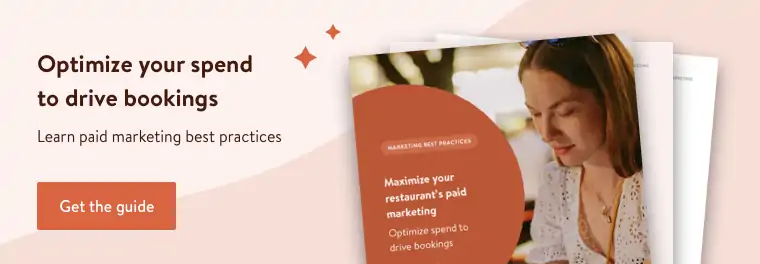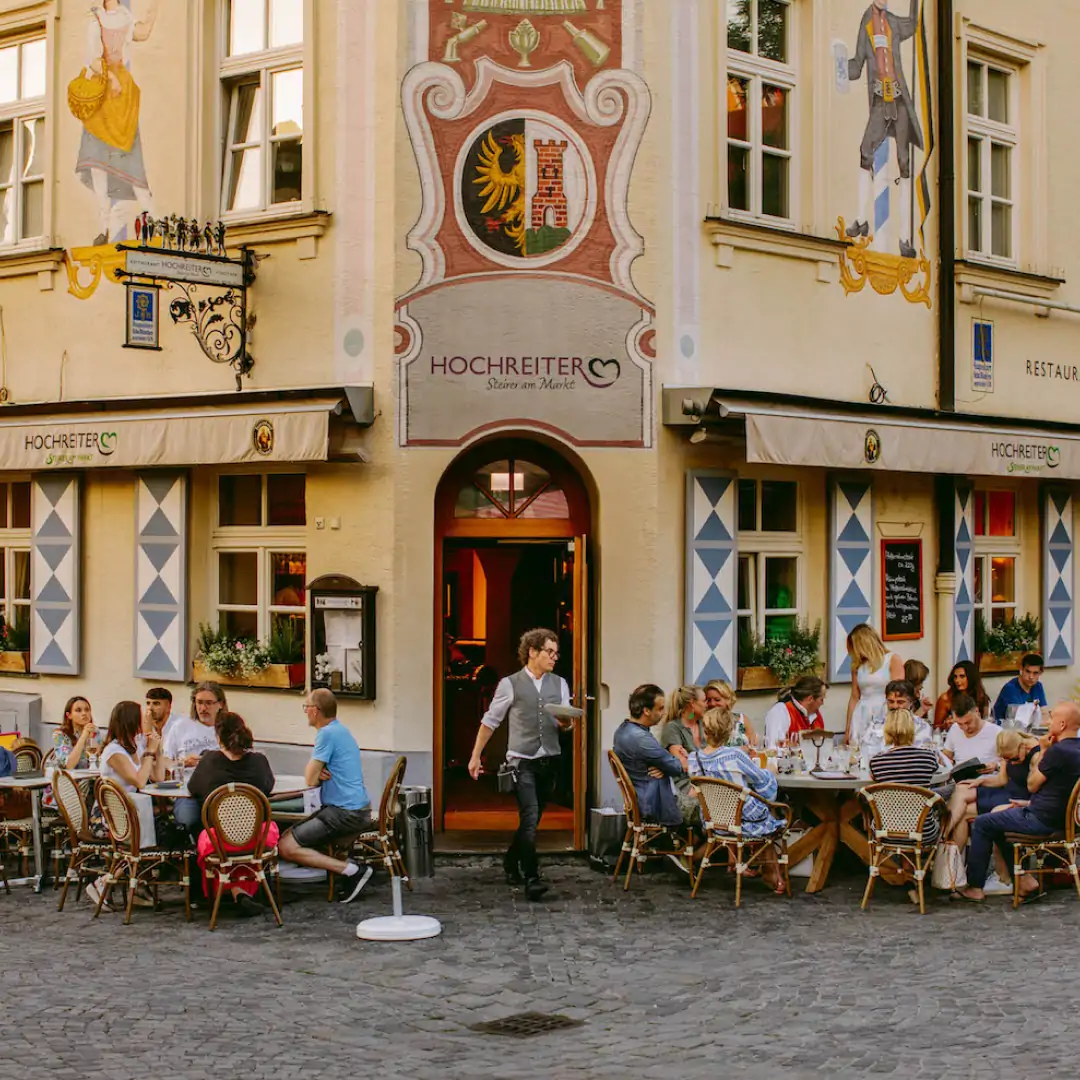When it comes to restaurant marketing, most restaurants have similar goals: to build their brands, fill their seats, and stay top of mind. How they achieve those goals is an entirely different matter–and doing so requires a clear understanding of the return on their investment.
We get it: most of you didn’t get into the restaurant business because you love marketing. But the truth is that in this competitive industry, even the most successful restaurants need to invest in marketing. Likely, you’re using some combination of social media, PR, email, and paid advertising to reach potential guests. But how do you really know what’s working?
Below, we share an overview of the top paid marketing channels for restaurants, including what they do, who they speak to, what you’re actually paying for, and how to think about results. Plus, we share how through OpenTable, you can track your paid digital marketing spend back to diners who actually dine in your restaurants to understand the true ROI.
Facebook and Instagram
What they say: Two billion people use Facebook every month to connect with friends and family and to discover things that matter. Find new customers and build lasting relationships with them.
How it works: With about two billion monthly users, Facebook and Instagram are all about reach and brand awareness. That means you’re paying for eyeballs–the opportunity to get your restaurant in front of the immense number of people who use the platforms.
Using the Ad Manager, you select a goal, audience, budget, and schedule, then create an ad with image and copy. Facebook provides metrics to measure campaign results, including reach (the number of people who saw the ad at least once), impressions, number of clicks on that link, and more. You can see the cost per landing page views and, of course, your total amount spent.
What you need to know
- Expertise and resources help. Advertising on Facebook and Instagram takes time, and requires research and strategic direction. Yes, the Ad Manager will make suggestions for copy and placement, but those recommendations aren’t always the most effective–so it’s up to you to get it right.
- It’s competitive. The ever-increasing number of businesses using Facebook and Instagram ads means that getting an ad noticed is harder than ever. You may want to consider creative ad sets, which can come at additional cost.
- Users aren’t always looking to book. Facebook and Instagram have a massive scale, but diners don’t go there specifically to discover new restaurants or make a reservation.
- You’re paying for views and clicks. Facebook and Instagram charge for ad views and clicks, and ROI tracking (to see how many diners the ad drives) is limited. For each ad, we recommend you ask yourself: was your ad necessary to drive reservations, or were those diners going to book anyway?

What they say: Get in front of customers when they’re searching for businesses like yours on Google Search and Maps. Only pay for results, like clicks to your website or calls to your business.
How it works: Google sees 3 billion searches per day, so the platform is all about reaching people with intent to book. You don’t have to spend money to be found on Google. Learn how to optimize your organic SEO with these tips. If you do decide to invest in advertising, unlike Facebook and Instagram, the goal here is to generate leads, so you pay when diners find you through Google.
Much like with Facebook and Instagram, when you launch a Google ad you will pick a goal and location, define your product and service using keywords, and finally create your ad and set your budget. Google’s Ad Manager shows metrics like clicks through to your website, impressions, and cost per click, including your total spend.
What you need to know
- Again, you need some expertise. You can set up Google ads yourself, but knowing the basics will only get your so far. Running effective campaigns requires monitoring closely and tweaking to optimize results.
- Be smart about keywords. Picking the right keywords to start with Google ads is crucial–just as important as the monitoring and tweaking you do along the way. Research keywords or talk to an expert before you get started.
- It’s not about pictures. Google ads are text-only, which means you won’t be able to draw people in with your best food photos. Instead, focus attention on the messaging in your copy.
- Keep an eye on your spending. Businesses of all sizes (and budgets) are vying for attention via Google ads. When businesses target the same keywords, you may end up paying more to advertise, so it’s easy to spend more than you planned. Constant monitoring is key.
- You’re paying for clicks. Google Ads is a pay-per-click service—that means you may spend a significant amount of money and see little to no ROI. Don’t forget, you ultimately want diners to book a reservation, not just land on your website.

Yelp
What they say: Millions of people turn to Yelp every day to make spending decisions. Stand out to a community of millions of people ready to buy, visit, and hire.
How it works: With Yelp Ads, you pay for eyeballs and leads. To get started, you create your ad and set your budget and target audience location. The platform provides metrics like impressions, clicks, cost per click, and total spend to measure campaign results.
In addition, the Yelp for Business dashboard—for professional accounts—shares user views and customer leads, including clicks to your website, to user-uploaded photos, CTA links, directions and may views, and mobile check-ins. Business accounts can also see an estimate of their generated revenue and the number of times a business appears in search results.
What you need to know
- “Leads” are loose. Yelp has a loose definition of a lead, so the majority of interactions with a Yelp profile may be counted as one. Take that into consideration when reviewing campaign results.
- Audience targeting is limited. Unlike advertising on Facebook, Instagram, or Google, Yelp doesn’t let businesses choose how or whom they target. Yelp controls radius coverage and keywords, and specifics about their targeting algorithm are hard to come by. As a business, you will likely get clicks from irrelevant prospects, potentially wasting your ad spend.
- Watch out for added costs. Yelp charges businesses additional fees for features like adding a CTA to a Yelp profile and restricting competitor ads on your business’s profile.
- Measuring results can be tricky. Tracking leads and measuring the ROI of Yelp ads is challenging – businesses pay for clicks, but there’s no way to measure whether the click resulted in a seated diner. Plus, Yelp doesn’t allow for any third-party tracking tools.
Know your ROI with marketing tracking
The best marketing tracking should show you how metrics like impressions, reach, and clicks become booked reservations and seated covers. OpenTable’s marketing tracking feature offers visibility into the sources of your guests’ reservations, so you can track and compare the effectiveness of each channel and campaign in driving bookings. With free POS integration, you can also measure your digital marketing spend to your actual reservations and revenue. That gives you the power to optimize your marketing budget and plan future campaigns using data from OpenTable reporting.
Takeaway
All of these platforms have their strengths and weaknesses, and as a restaurant operator, it’s not always obvious where to invest. Our tip: consider your priorities. Whether you’re seeking brand awareness, leads, or seated diners, choose the best platform for your goals.
Finally, remember that the largest audience isn’t always the best one. OpenTable has the largest dining network in the world—people who use our platform every day to discover and book tables at restaurants around the world. OpenTable marketing solutions can amplify your exposure to undecided diners at the exact moment they’re looking to book, and give useful insights on performance so you can easily see ROI. With us, every dollar you spend is focused on driving reservations, not just exposure—so you always know what’s working. Learn more about OpenTable marketing solutions here.





